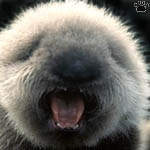
Baby sea otter, Paramushir, Kuril Is.
Part 3: North Pacific and Russian Arctic
California might be the world's best place to see marine mammals,
but there are many other great locations in all oceans, most seas, and even some
rivers and lakes.
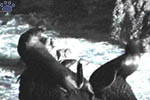
Steller's sea lions,
Sea Lion Caves, Oregon. |
Coast between California and Alaska
is spectacular, but marine mammals are less diverse. The best site is Sea Lion
Caves - a colossal sea grotto with a large rookery of Steller's and California
sea lions. Fjords further north are a good place to look for porpoises and resident
killer whales. |

Killer whale from a resident, fish-
eating pod, off Vancouver I, Canada. |
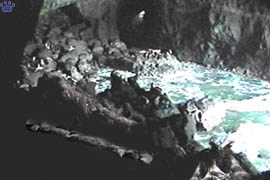
Sea Lion Caves, Oregon. |
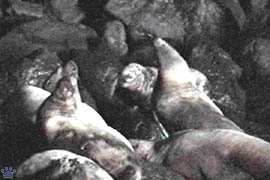
Steller's sea lions in the Caves. |
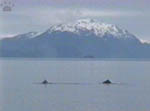
Humpbacks in Glacier Bay, Alaska. |
In the fjords of Alaska,
you can see all of them plus minke whales, humpbacks and Northern sea otters (E.
l. lutris).

Sleeping humpback, Glacier Bay. |
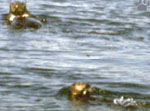
Sea otters, Glacier Bay. |
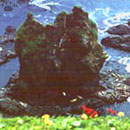
Harbor seals' haulout,
End of the World Cape,
Shikotan, Kuril Islands. |
Originally, the waters off Japan
were probably even better than California, but centuries of slaughter have lead
to extinction of some species and severe decline of others. Now only the most
remote island groups have large populations of marine mammals. Kuril
Islands (taken by Russia in 1945) are one of the best places - most species,
except for those wintering in Japanese waters, have completely recovered. |
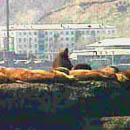
Steller's sea lions
in Nevelsk City harbor,
Sakhalin Island. |
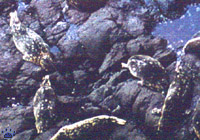
Harbor seals, End of the World Cape,
Shikotan, Kuril Islands. |
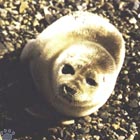
Baby harbor seal,
Matua, Kuril Islands. |
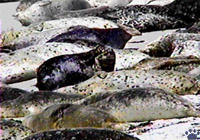
Bearded seal (Erignathus barbatus nauticus)
and spotted seals (Ph. largha), Magadan, Russia. |
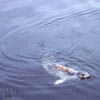
Spotted seal following a
fishing boat, Severo-
Kurilsk, Kuril Is. |
Unlike in America, Asian harbor seals
Ph. v. stejnegeri are usually difficult to approach, because they are often
joined by wary spotted seals, their close relatives. Unlike Pacific harbor seals,
spotted seals mostly breed on ice floes, but in summer they haul out on beaches
and rocks, especially in the southern parts of their range. In the Sea of Okhotsk,
they are sometimes joined by bearded seals, normally seldom seen far from ice
floes. |
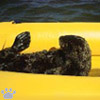
Southern sea otter (E. l.
australis), playing in my
boat, Matua, Kuril Is. |
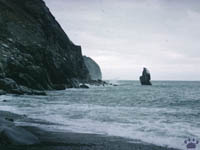
Iona Island in central Sea of Okhotsk - site of the
World's largest Steller's sea lion colony. |
Cold and beautiful, the Sea of Okhotsk
has resident populations of some other Arctic animals, such as beluga whale (Delphinapterus
leucas), as well as whales, dolphins and pinnipedes typical for temperate
seas. |
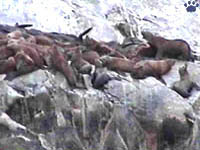
Steller's sea lions often haul out on steep rocks.
Iona Island, Sea of Okhotsk. |
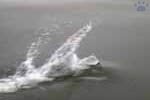
Coastal form of Dall' porpoise (Ph. d.
var. truei), off Iturup, Kuril Is. |
The sea of Okhotsk is also the best
place to see the last North Pacific right whales (B. japonica). Some difficult-to-see
species, such as ribbon seal and bowhead whale (B. mysticetus), also occur
here. But don't expect to find whalewatching tour operators in the area! |
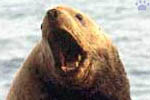
Male Steller's sea lion,
Shantar Islands, Sea of Okhotsk. |

Ribbon seal (Ph. fasciata),
Shelikhov Bay, Sea of Okhotsk. |

Northern right whale,
Paramushir, Kuril Islands. |

North Pacific right whale,
Paramushir, Kuril Islands. |

Ringed seal (Ph. hispida ochotensis),
Shelikhov Bay, Sea of Okhotsk. |
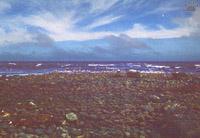
Bones of Steller's sea cow (Hydrodamalis gigas)
are still easy to find on local beaches. Bering I. |
Commander
Islands, the Russian part of Aleutian chain, are one of
the most remote island groups in the North Pacific. They had no native population,
so the giant Steller's sea cow survived here until the 18th century. |
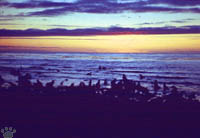
Rookery of Northern fur seals (Callorhinus
ursinus), Bering Island, Commander Is. |
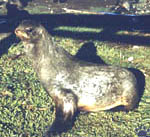 |
Northern fur seals only haul out
on islands with no bears present, such as the Central Kirils, Commander Is., and
the Pribilofs.
|
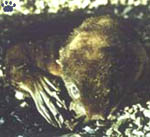 |
| Northern fur seals, Bering
Island, Commander Is. |
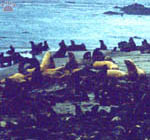
Northern fur seals and Steller's sea
lions, Bering Island. |
In addition to giant fur seal rookeries,
the Commander Islands are a good place to see many other marine mammals, including
some beaked whales.

Stejneger's beaked whale (Mesoplodon stejnegeri),
off Mednyi (Copper) Island, Commander Is. |
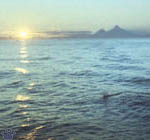
Cuvier's beaked whale (Ziphius
cavirostris), off Kamchatka. |
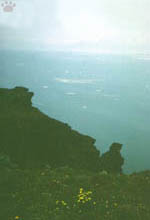
Summer view of Bering Sea from
Cape Kriguigun, Chukotka. |
Wedged between
Bering and Chukchi Seas, Chukotka (Chukchi
Peninsula) is one of the most interesting places in the North.

Ringed (Ph. hispida hispida) and bearded seals, off Chukotka.
It has the highest biodiversity in the Arctic, both on land and in the sea. Some marine mammals occur in huge numbers here. |
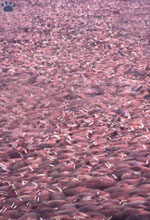
Walruses at Cape Dezhnyov,
Bering Strait, Chukotka. |
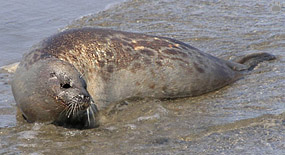 |
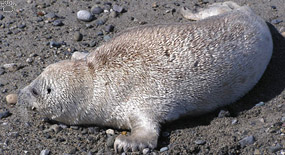 |
| Juvenile ringed seals, Russkaya Koshka Spit, Chukotka. |
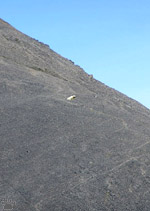
Polar bear summering on a
mountaintop, Egvenkinot, Chukotka. |
The star attraction
is Pacific walrus (Odobenus rosmarus divergens). Unlike two other walrus
subspecies, which are largely confined to ice floes, Pacific walruses haul out
on certain beaches in great numbers. Walrus colonies exist in summer in many parts
of Chukotka and at a few remote locations in Alaska; in winter they can be seen
in Eastern Kamchatka and Commander Islands. Polar bears (Ursus maritimus) are common on the mainland in winter, but very rare in summer. |
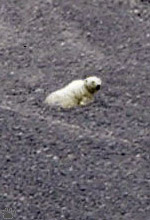
Polar bear summering on a
mountaintop, Egvenkinot. |
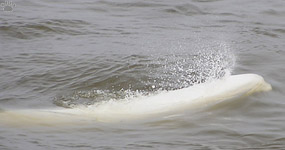 |
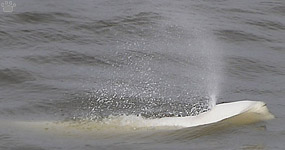 |
| Beluga whales, Anadyr Airport ferry pier, Chukotka. |
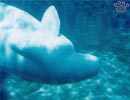 Beluga whale, Anadyr.
Beluga whale, Anadyr. |
Every summer, great numbers of whales, walrus
and seals migrate from Pacific to Arctic Ocean and back through Bering Strait.
The most common cetaceans are gray and beluga whales. Anadyr Airport pier
is the best place in the World to swim with belugas (July-September). |
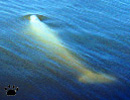 Beluga whale, Anadyr.
Beluga whale, Anadyr. |
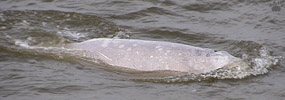 |
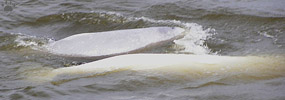 |
| Juvenile belugas, Anadyr Airport ferry pier, Chukotka. |
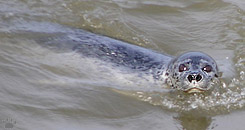
Spotted seal, Anadyr. |
Spotted seal is very common in southern Chukotka. |
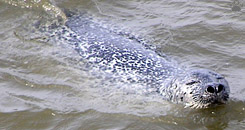
Spotted seal, Anadyr. |
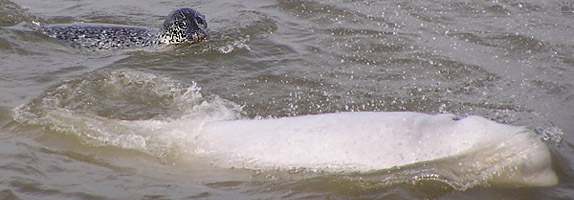
Spotted seal playing with a juvenile beluga, Anadyr Airport ferry pier, Chukotka. |
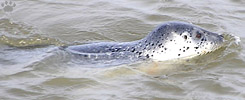
Spotted seal, Anadyr. |
It prefers protected bays and river mouths. |
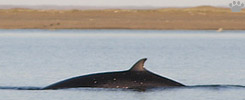
Minke whale (Balaenoptera acutrostrata), Belyaka Spit. |
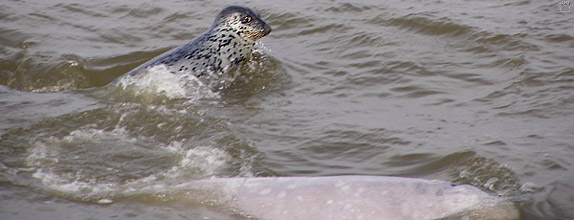
Spotted seal playing with a juvenile beluga, Anadyr Airport ferry pier, Chukotka. |
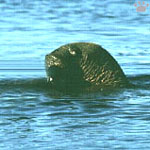 Walrus, Vrangel Island.
Walrus, Vrangel Island. |
Vrangel Island
north from Chukotka has the largest walrus haulout of all. More
than 1/2 of World's polar bears are born here and
on adjacent Herald Island. Ringed and bearded seals are abundant year-round,
while spotted and sometimes ribbon seals show up in summer. |
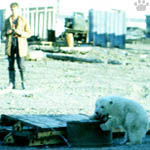 Author and polar bear cub, Vrangel I.
Author and polar bear cub, Vrangel I. |

Chukchi Sea off Vrangel Island. |
The area around the island is a
good place to look for bowhead whales from late June to early September.

Bowhead whale, off Vrangel Island. |

Eastern coast of Vrangel Island, July. |
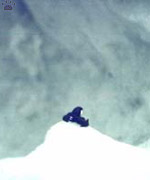
Laptev Sea walruses (O. r. laptevi),
Bennet I., De Long Islands. |
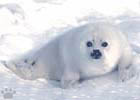
Baby harp seal (Ph. groenlandica), White Sea.
Other seas and islands of Russian Arctic are also very interesting, but, unfortunately,
it is extremely difficult and/or expensive to get there. |
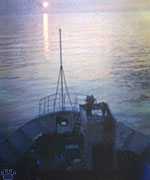
Summer in White Sea off
Solovki Islands, Russia. |
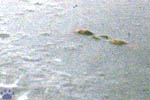 Narwals (Monodon monoceros) in
Narwals (Monodon monoceros) in
freezing sea, between Severnaya
Zemlya and the North Pole. |
The most common mammals here are beluga,
ringed (Ph. h. hispida) and bearded seals and polar bear, but many other
species occur, especially in nonfreezing areas near the mouths of large rivers,
and in relatively warm Barents Sea. Here some Atlantic mammals show up in summer,
following the Gulf Stream. |
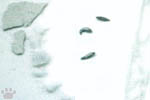 Hooded seals (Cystophora cristata)
Hooded seals (Cystophora cristata)
are very rare in Russian Arctic.
Victoria Island, Barents Sea. |
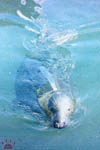
Gray seal (Ph. gryphus), Barents Sea
off Iokanga,
Russia. |
Fjord-ridden Western coast of Novaya
Zemlya is probably the most interesting part of Russian Arctic, but other island
groups are also worth visit.
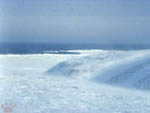
New Siberian Islands in winter. |
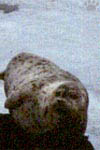
Atlantic harbor seal
(Ph. v. vitulina),
Novaya Zemlya. |
Part 4: Canada
Back to Part 2
Home
|